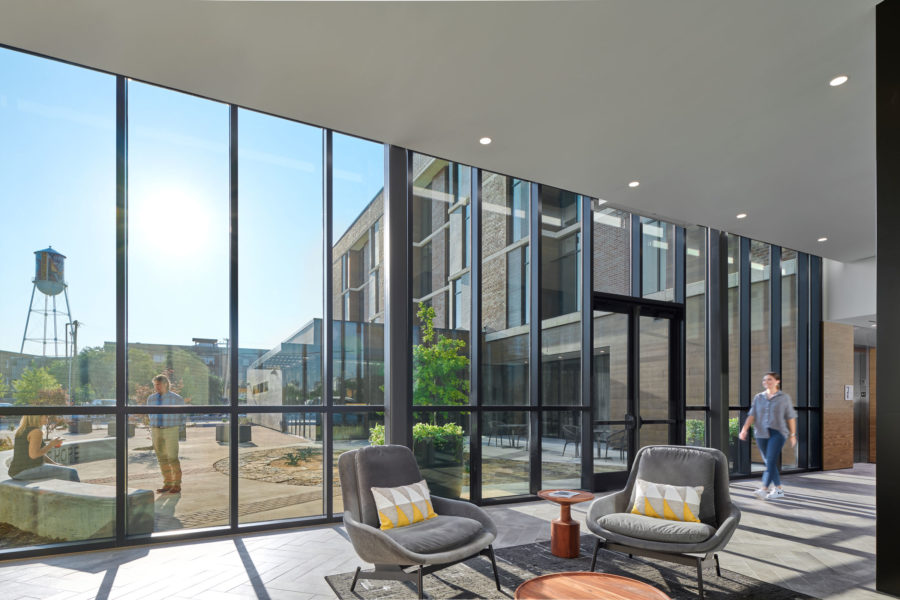Story at a glance:
- Writing sustainable specifications has many steps, including educating design teams.
- Design teams should begin projects by asking what their sustainability requirements are.
- Well-coordinated written documentation can make the difference in whether a project will meet its sustainability requirements.
Specifications are the written requirements that define the attributes of construction materials and processes that will be used for a project. As such, they document important sustainability requirements and characteristics.
Over the last 20 to 25 years, sustainable design has become a critical consideration to owners, building occupants, and communities. When working to sell or lease a building, owners have become aware that occupants and buyers have sustainability top of mind and consider the impact construction and its processes have on the environment.
By including and documenting project sustainability requirements, the design team— including specification writers—can help create a healthier planet one project at a time. The development of specifications will consider sustainability in evaluating which building products and systems to include. There are, however, many steps involved in writing sustainable specifications, including determining the overall sustainability requirements, deciding who will specify what, coordinating submittals, and educating design teams.
How to Determine Sustainability Requirements

Exterior view of Hope Lodge in Dallas. Photo by James Steinkamp

Inside Hope Lodge, Dallas. Photo by Peter Molick
When a team begins a new project, the first question a specifier should ask a team is: “What are the sustainability requirements for this project?” From there, one should determine the project goals of both the design team and owner: Will the project be going for a particular sustainable design certification? Is there a checklist with requirements?
The answers to these initial questions will inform what products and systems will need to be specified to ensure they meet the project’s sustainability requirements. Specifications are part of the “contract documents,” and when sustainable attributes are listed, they should be considered as requirements, not goals. Once products and systems are chosen, a team must figure out how they will work together and determine whether they will meet code and other requirements. These considerations, as well as careful documentation, are critical for the success of a project. In fact, well-coordinated written documentation can make the difference in whether a project will meet its sustainability requirements or not.
When working on a project, an owner often wants to include sustainable elements but may not want to complete or pay for an official certification program like LEED, WELL Building Standard, or the Living Building Challenge. Instead, we see more requests for projects to be considered “LEED-like” or “LEED-light.” We specify many of the same attributes for certification requirements for these types of projects but without verification and extra submittals.
When working through this coordination process, whether for certification or not, the specification writer must determine what product or system requirements to include. Scorecards used for calculating project certification requirements can be utilized by designers looking to pick and choose effective sustainable design strategies for their projects. Not only can one of these scorecards help with documentation and strategy, but they can also sometimes be used to educate an owner and help change their perspective on having their building or project certified.
Where Do You Put Sustainability Requirements?

Sustainability was taken into consideration from the very beginning of the Hope Lodge Dallas project. Photo by Peter Molick
Every project should have minimum sustainability requirements for products and systems. In addition to the importance placed on these requirements by owners and building occupants, many have become required by code.
The questions are:
How do you develop them?
Where should the requirements go?
And how do they get documented?
Some specification writers put all the sustainability requirements in one place. This would typically entail developing a specification section in Division 01 General Requirements that will govern the requirements for every section.
Putting all sustainability requirements into one general section neatly packages everything in one place. Therefore changes can be easily coordinated. A statement in each individual technical section that references back to this document is a great tool if the information will trickle down and be shared from the contractor to their subcontractors. However, specifications are typically divided out by division or work results and a subcontractor who’s doing one part of the work may only receive or review the section that applies to their particular work result. Others spread the requirements out in the individual technical sections by putting broad requirements in a single general section and expanding upon them further by topic or system in each individual section.
On the other hand, many specification writers develop a Division 01 sustainability section that includes the broad overall administrative and procedural rules for a project. Doing so helps develop specific information in the technical sections with requirements that would relate to a particular product or work result. By providing both a general section and sections with more specific individualized requirements and cross-referencing them, contractors and their subcontractors will be made aware of all requirements necessary to document sustainability.
Because the industry is changing so rapidly, many contractor teams are having trouble keeping up and understanding all of the requirements necessary to construct a sustainable building. Providing a general overall section and then expanding the sustainability requirements in each section ensures the subcontractor who is performing the work has all of the requirements.
Communication, Teaching, and Mentoring

Inside the Perkins&Will Dallas studio. Photo courtesy of Perkins&Will
Every team member—specifiers, sustainability leaders, and designers—needs to communicate and coordinate to advance the sustainability requirements for a project. Sometimes a disconnect exists between the sustainability team members, designers, and specification writers when choosing and specifying sustainable products. This is because specification writers do not necessarily write sections for every discipline. Instead, the specifier working for the architect gathers and packages sections that are typically written by disciplines who are employed by a different firm. Specification writers employed by a firm and consultant specification writers alike normally only write architectural sections. They have little or no control over the structural (where there is currently a lot of concern about carbon and concrete sections) or MEP sections where a big part of sustainability can happen. This problem could be solved with coordination and review of documents to ensure sustainability requirements are documented correctly.
A specification writer can only specify what designers choose. Therefore, the specification writer’s job is to help educate designers on more sustainable options when choosing products to include in a design. They can provide information, help with selection, review, and provide an introduction to manufacturers and product representatives who can provide valuable insight on the sustainability of their particular product or system.
Education plays a significant role in a specifier’s job and comes into play quickly, as some team members may not have written specs before or may not fully understand the process. Taking the necessary time to educate and mentor teams about specifications and the requirements of the evaluation, documentation, and writing process is critical. Sharing information, actively participating in the process, suggesting alternatives, and explaining similarities and differences while being a resource to a project team can go a long way in the education process for not only design team members but specifiers as well.
Overall, specifiers play a vital role in developing and completing sustainable projects. Specifications provide contractors with clear instructions on overall project intent, performance, and construction.




